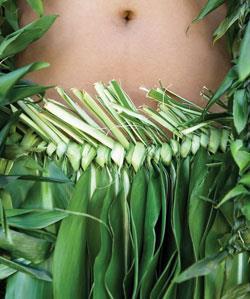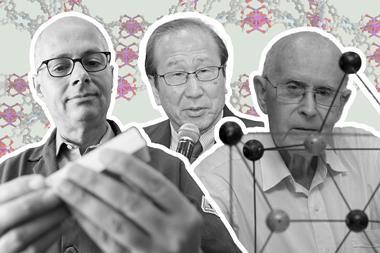Synthetic fibres are back in fashion after an ecological makeover.
Synthetic fibres are back in fashion after an ecological makeover.

Even the fickle world of fashion has an environmental conscience. Style is paramount, and retailers are battling to keep costs low and shoppers tempted, but we consumers are increasingly aware of the green credentials of all industries - including fashion. Many designers are vying to stay ahead of the game, publicising their use of natural, renewably sourced fibres - such as organic cottons, hemp, bamboo and even nettle.
So how can products of the chemical industry - the synthetic fabrics like nylon and polyester that once revolutionised the textiles trade - compete? Manufacturers of a group of novel synthetic materials are entering the market, aiming to do just that, and to bring some new chemistry into an industry that is becoming increasingly aware of its environmental obligations.
Fibres for fabrics come in three types: natural (cotton, silk, wool); cellulosic (viscose, acetate, cupro) or synthetic (polyester, acrylic and nylon). Cellulosic fibres are regenerated from chemically treated cellulose, originally derived from wood pulp; while synthetics are derived from petrochemicals.
Man-made fibres have already begun to dominate the market. Cotton has always been a big seller, but according to industry analysts Textiles Intelligence’s latest outlook (published in January), man-made fibres, including cellulosics and synthetics, accounted for 58 per cent of all fibre demand in 2006. Within this category, it is polyester -
poly(ethyleneterephthalate) or PET - that is powering demand.
So the environmental impact of these fibres has become much more significant, and, for traditional synthetics, the picture is far from green. They are derived from petrochemicals, meaning their production depends on declining reserves of oil and gas and they are not renewable. Also, their production is energy-intensive, the fibres don’t biodegrade and they are not easy to recycle.
Biofabrics
This is why some companies are seeking to develop ’greener’ alternatives. ’Most manufactured synthetic fibres rely heavily on finite oil resources,’ says spokeswoman Bridget Charon from NatureWorks, a US company that makes Ingeo fibre from a polymer derived from corn. ’Price volatility and availability are key issues that will impinge on the market more and more. Within 10 years, we expect oil-based fibres to be under such pressure that more sustainable solutions will be needed to keep up with global demand.’
But are consumers looking for environmentally-friendly fibres? ’To entice clothing companies into the "alternative fibre" market, developers need to be sure that consumers are ready,’ says textiles consultant Kate Fletcher, author of Sustainable fashion and textiles: design journeys, published in January. ’There are statistics that indicate consumer willingness to choose more responsibly [produced] fibres, and growth in the ethical clothing market is increasing very rapidly - albeit from a very small base.’ Market research from Globescan Eurisko back in 2005 showed that 85 per cent of Italian consumers, closely followed by Germans, Canadians, Britons and finally Americans (79 per cent), would be happy to pay an extra 10 per cent for a product that does not harm people and the environment.
’The retail industry is fuelling demand,’ says Josef Spikyers of CIRFS, the European man-made fibres industry association. ’Also regulators, such as the European Commission, have responded by promoting the eco-label to set environmental criteria for fabrics.’ However, Spikyers says all CIRFS’s research shows that consumers still look first at performance and cost; and then at environmental considerations.
And here’s the rub - alternative fibres come with a premium price tag attached. What’s more, sometimes they can’t match their mainstream competitors when it comes to a range of performance properties, says Spikyers. Take fibres like Ingeo, made from poly(lactic acid) or PLA. ’PLA fibres are the biggest player,’ says Spikyers, ’but they are so far only used in niche markets because they cost several times more than regular polyester and their performance properties are not so good. The problem is that the melting point of the polymer is lower and this sets limitations on its production and its applications. For example, ironing temperatures are limited.’
There are drawbacks, agrees Fletcher. ’But, what’s critical is that something is being done - people are taking action and making changes to meet the goal of sustainability.’
Image is everything
Given time and more investment, both Fletcher and Spikyers agree that these products will match their natural competition. But launching any new fibre into an already crowded marketplace is difficult. ’I think the niche perception - all sustainable clothes are beige or can’t be washed enough - is changing,’ says Fletcher. ’There’s a buzz around alternative materials at trend shows.’
Companies like NatureWorks are prepared to wait. ’Polyester took many years to break through because in the beginning, nobody understood how to process and dye it,’ says Charon. ’The apparel industry is always hungry for new ideas and products that can offer new aesthetics or performance benefits. Once these are tested and applied, the industry relies on good communication throughout the chain to take this message of innovation to the end consumer.’
Marketing these fibres is critical. ’It can be very hard for the "green" voices to be heard; they can be marginalised and overwhelmed by the mainstream,’ says Sandy MacLennan, textile designer and developer. That’s why he teamed up with Giusy Bettoni, a marketing and PR consultant, to launch Class (Creativity, Lifestyle and Sustainable Synergy) last September at Milan Fashion Week, which brings these niche products together under one umbrella.
’Producers of sustainable fabrics can find it hard to get their fabrics seen by designers, and designers can struggle to source environmentally friendly fabrics,’ explains MacLellan. ’Class aims to get each side talking to the other. Producers get a chance to show off their latest "green" fabrics fresh out of the lab, and designers get a one-stop shop in our showroom in Milan.’
Producers can also take advantage of marketing advice in the drive to make sustainability chic. But the bottom line from the designers is: clothes have to perform well and look good to survive the market.
To be included in Class, manufacturers don’t have to tick all the ’green’ boxes. They just need to have taken one or more steps in the right direction, whether that’s improving their manufacturing processes or raw materials sourcing, or developing organic dyes. ’This is a developmental journey, bringing these products towards the market,’ explains MacLellan. ’But I am convinced that there will be a shift in the future where these responsible products are the norm.’
NatureWorks - a joint venture between Cargill of the US and Teijin of Japan - is one of Class’s partners. It launched Ingeo in 2003 as the world’s first man-made fibre derived from annually renewable resources (corn in this case).
Ingeo is based on PLA. First discovered in 1932, PLA is a linear aliphatic thermoplastic polyester derived from plant matter. Initially, its uses were limited to biomedical applications, such as sutures, but over the past decade, NatureWorks has developed commercially viable large-scale operations to produce PLA for use in packaging and fibres. It produces Ingeo at its facility in Blair, Nebraska, in the US, which has a PLA capacity of 140,000 tonnes per annum.
PLA is made by extracting the starch from plants and converting it into a fermentable sugar, such as glucose, by enzymatic hydrolysis. NatureWorks currently uses corn, but it is working to develop new conversion technologies that use feedstocks such as corn stover (the residue left in the field), grasses, wheat and rice straws, and bagasse (the residue of sugar cane production).
Fermentation of the plant sugars produces lactic acid. When water is removed, a cyclic intermediate dimer - lactide - is produced. NatureWorks has patented a process involving ring-opening polymerisation of the dimer under heat, without the need for solvent, using tin-based catalysts.
The trick is to synthesise both lactide and PLA in the melt rather than using solvents during the polymerisation process. This has both environmental and economic benefits, Charon explains. It avoids handling large quantities, along with the potential for fugitive emissions. Processing solvent streams and removing them from the polymer also consumes a lot of energy. NatureWorks uses distillation to purify the lactide, which results in higher yields when compared to solvent recrystallisation, which can lose more than 10 per cent of the crude lactide.
The green label
So what exactly are the environmental credentials of Ingeo? According to the company, the cradle-to-factory-gate production process of NatureWorks’ biopolymer uses 62-68 per cent less fossil fuel resources than traditional plastic materials, such as PET. No fossil fuel resources are required to build the polymer chain and the required electricity is produced by wind power. In all, this means that greenhouse gas emissions are down by 80-90 per cent. Products can be composted in industrial composting facilities and, in the future, may be chemically recyclable (back to the monomer).

But, for anyone who has ever melted a polyester shirt to their iron, Ingeo does have its drawbacks. It can only be ironed at low temperatures. But Charon insists that this shouldn’t pose a practical problem, as, like polyester, it doesn’t crease very much.
Another corn-based fibre is Sorona, made by DuPont from 1,3-propanediol (PDO) and a petrochemical-based monomer. DuPont pioneered a way to produce PDO from corn sugar using a patented, proprietary fermentation process. Sorona contains 37 per cent renewably-sourced ingredients by weight, according to Dawson Winch of DuPont Applied BioSciences.
In 2004, DuPont formed a joint venture with Tate & Lyle, a major corn-based products company with expertise in fermentation processes, to produce Bio-PDO. The Bio-PDO plant, in Loudon, Tennessee, in the US, is the world’s largest aerobic fermentation plant and is capable of producing 100 million pounds of Bio-PDO annually.
According to Winch the production of Sorona has an impressive list of environmental benefits: it is based on renewable feedstocks; it produces 63 per cent less greenhouse gas emissions than that of an equal amount of fossil fuel-based nylon; and it uses 30 per cent less energy.
It doesn’t have the famous tenacity of nylon, but the company says it offers other advantages over both nylon and polyester. It is softer and two to three times stretchier than nylon. And, as it is chlorine- and UV-resistant, it holds bright, bold colours well.
DuPont says these properties are derived from a unique, semi-crystalline molecular structure featuring a pronounced ’kink’. When the molecule undergoes stress, strain deformation occurs first in its crystalline regions. As stress is released, the crystalline structure locks in, allowing a complete recovery to the initial shape.
Fibres made with Sorona can be dyed at a lower temperature than polyester, without requiring pressure or chemical carriers. The Sorona polymer molecule enables the crystalline structure of the fibre to begin accepting the dye pigment below the boiling point, at approximately 85?C.
Although Winch will not divulge figures for demand or production, he reports that DuPont is expanding capacity in Asia - building a plant in China with its Chinese partner Glory - and the US. ’Introducing any fibre is challenging,’ he says, ’especially when the fibre has an environmental story. Our fibre is also different since the ingredients are from agricultural feedstocks. Not only is the fibre new, but the process used to produce the polymer ingredients is new, so we have been working to educate people on its performance benefits and attributes, as well as the environmental benefits.’ Dupont is backing Sorona’s potential to grow into a significant market over the next 10 to 20 years, and has priced Sorona ’in the range of nylon’, says Winch.
Textiles from trees
Where Ingeo and Sorona are based on fast-growing corn, Viscose, Modal and Tencel (lyocell), from Austria-based company Lenzing, are made from wood pulp. These high-purity cellulose fibres are obtained from sustainably managed forests, according to a report by the University of Cambridge’s sustainable manufacturing group. Compared with cotton, wood has the advantages of low water consumption, reduced pesticide use and produces up to 10 times the amount of cellulose per hectare, states the report. And these fibres are 100 per cent biodegradable.
Lenzing first launched Tencel in 1995 in the UK. It is made using a patented solvent spinning process. ’What makes this process innovative is that the solvent is kept within a closed loop,’ says Christina Kreuzwieser of Lenzing. ’There is no wastewater and very low emissions, which is completely different from the typical viscose production process.’ Up to 99.5 per cent of emissions can be recovered, and the remainder is decomposed in adapted biological purification plants. The process takes about a third of the time of viscose production and uses less energy.
The company uses a proprietary nanotechnology that produces fibre made up of ’nanofibrils’. These tiny channels are controlled in regular arrangements. The nanofibrils are hydrophilic so they absorb moisture, which then spreads through the fibre, says Kreuzwieser. In fact, Tencel can absorb 50 per cent more moisture than cotton. As a result of these properties, Tencel is good for sensitive skin, she adds.
However, there is a price to pay for these innovations; Tencel costs a third more than viscose. But the company is confident that, after initial teething problems 10 years ago with finishing processes, Tencel is now on track to grow. And according to the company, customers are convinced that the fabric’s green benefits outweigh the additional cost. ’We had to gain the acceptance of the industry initially,’ recalls Kreuzwieser. ’Now we are sold out.’
Maria Burke is a freelance science writer based in St Albans, UK
Further Reading
Textiles Intelligence
K Fletcher, Sustainable fashion and textiles: design journeys, 2008, Earthscan Publications, London.
Class
University of Cambridge sustainable manufacturing group






No comments yet